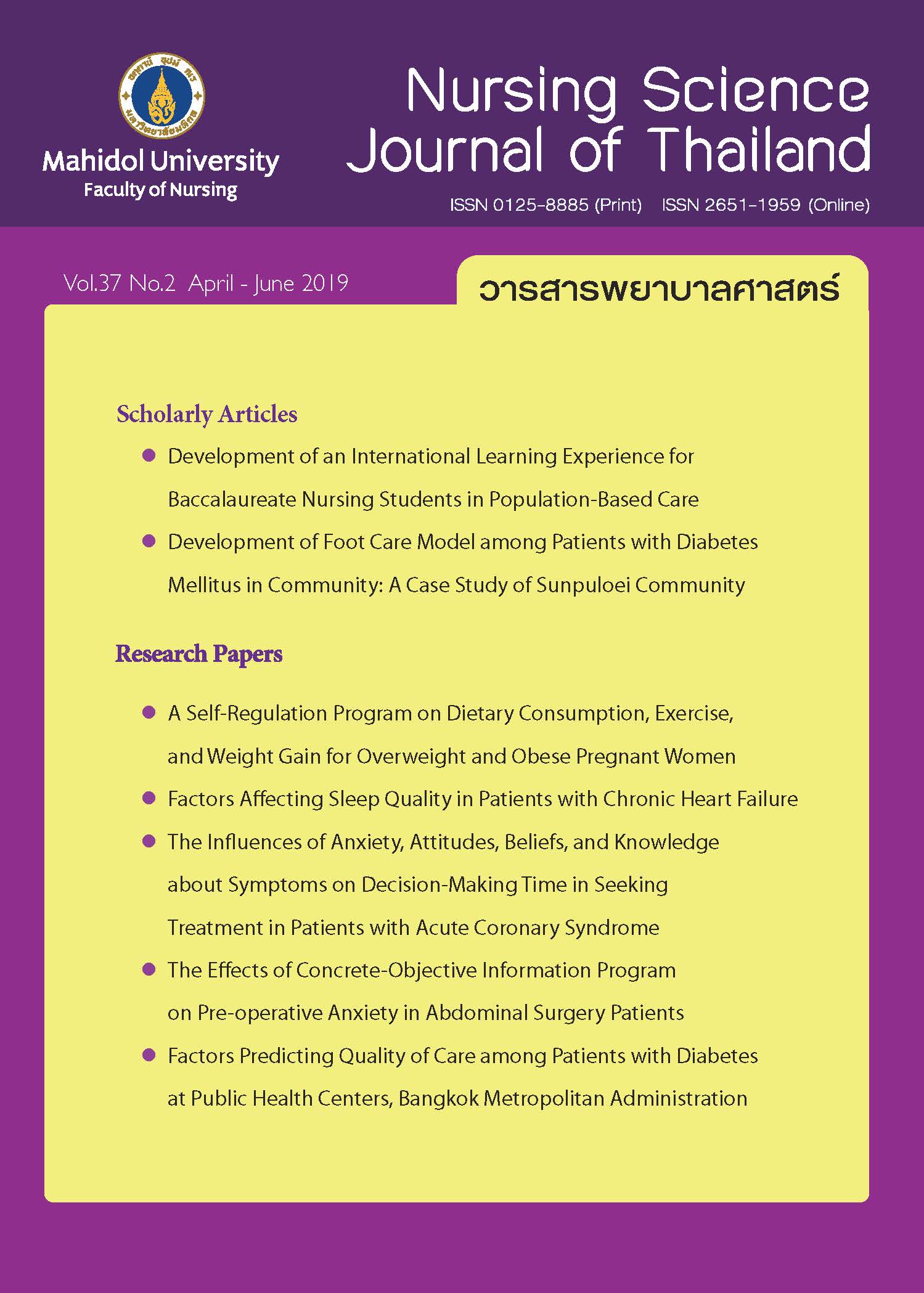The Effects of Concrete-Objective Information Program on Pre-operative Anxiety in Abdominal Surgery Patients
Main Article Content
Abstract
Purpose: The aim of this study was to study the effects of concrete-objective information program on preoperative anxiety in abdominal surgery patients.
Design: A quasi-experimental research (two group pre-posttest design).
Methods: The sample consisted of 62 preoperative abdominal surgery patients. They were divided into two groups, the experimental and control groups. Thirty-one participants were included in each group. The experimental group was received the concrete-objective information via video and usual nursing care while the control group was received only usual nursing care. Data were collected using a demographic data record form and Visual Analog Scale–Anxiety (VAS-A) assessment form. The patients’ anxiety was assessed before receiving the program and twice after the program (immediately and on the day of surgery in the waiting room). Data were analyzed using Mann-Whitney U Test and Wilcoxon Signed-Rank Test statistical package.
Main findings: The results showed that on the day of surgery in the waiting room (posttest 2) patients who received a concrete–objective information via video had statistically lower mean scores of anxiety than those who received usual nursing care (p = .017). In addition, the anxiety mean scores in the experimental group immediately after receiving the program (posttest 1) was statistically lower than that before receiving the program (p = .001).
Conclusions and recommendations: Concrete-objective information program could reduce pre-operative anxiety in abdominal surgery patients. This program should be used to decrease the anxiety level during pre-operative period.
Article Details
Copyright Notice: Nursing Science Journal of Thailand has exclusive rights to publish and distribute the manuscript and all contents therein. Without the journal’s permission, the dissemination of the manuscript in another journal or online, and the reproduction of the manuscript for non-educational purpose are prohibited.

Disclaimer: The opinion expressed and figures provided in this journal, NSJT, are the sole responsibility of the authors. The editorial board bears no responsibility in this regard.
References
2. Ministry of Public Health, Office of the Permanent Secretary, Bureau of Policy and Strategy. Public health statistics A.D. 2014 [Internet]. Nonthaburi: Bureau of Policy and Strategy; 2015 [cited 2018 Jun 16]. Available from: http://bps.moph.go.th/new_/sites/default/files/health_statistics2557.pdf. (in Thai).
3. Sriuranpong V. The crisis “Colon Cancer” rating 3rd killed the Thais [Internet]. Bangkok: Thairat Online. 2014 Aug 30 [cited 2018 Jun 16] Available from: https://www.thairath.co.th/content/446778. (in Thai).
4. General and Vascular Surgery Unit, Perioperative Nursing Division, Nursing Department, Siriraj Hospital. The annual statistics report (2013-2015). Bangkok: Siriraj Hospital; 2015. (in Thai).
5. Melstrom LG, Fong Y. The management of malignant liver tumors. In: Cameron JL, Cameron AM, editors. Current surgical therapy. 11th ed. Philadelphia: Elsevier Saunders; 2014. p.328-32.
6. Long BC, Phipps WJ, Cassmeyer VL. Medical-surgical nursing: a nursing process approach. 3rd ed. St. Louis: Mosby-Year Book; 1993. 1728 p.
7. Kaplow R, Hardin SR. Critical care nursing: synergy for optimal outcomes. Sudbury, MA: Jones and Bartlett; 2007. 778 p.
8. Sompittayanuruk N. Surgical nursing: peri-operative nursing care. Bangkok: Police Nursing College, Police General Hospital, Royal Thai Police; 2010. (in Thai).
9. Maranets I, Kain ZN. Preoperative anxiety and intraoperative anesthetic requirements. Anesth Analg. 1999;89(6):1346-51.
10. Caumo W, Cardoso Ferreira MB. Perioperative anxiety: psychobiology and effects in postoperative recovery. J Pain Clin. 2003;15(2):87-101.
11. Agarwal A, Gupta S, Sharma RK. Role of oxidative stress in female reproduction. Reprod Biol Endocrinol. 2005 Jul 14;3:28. https://doi.org/10.1186/1477-7827-3-28.
12. Pokharel K, Bhattarai B, Tripathi M, Khatiwada S, Subedi A. Nepalese patients' anxiety and concerns before surgery. J Clin Anesth. 2011;23(5):372-8.
13. Johnson JE. Self-regulation theory and coping with physical illness. Res Nurs Health. 1999;22(6):435-48.
14. Sjöling M, Nordahl G, Olofsson N, Asplund K. The impact of preoperative information on state anxiety, postoperative pain and satisfaction with pain management. Patient Educ Couns. 2003;51(2):169-76.
15. Markland D, Hardy L. Anxiety, relaxation and anaesthesia for day-case surgery. Br J Clin Psychol. 1993;32(Pt 4):493-504.
16. Aksornsri A, Thammapanichwat W, Wichienchareon K, Saengperm P. The effects of concrete-objective information on parental anxiety and parental participitation in care for children in pediatric intensive care unit. Journal of Nursing Science. 2012;30(2):80-9. (in Thai).
17. Srikulwong T, Sasat S. The effect of concrete-objective information and giving information through social media on anxiety in pre-operative cataract adult patients. Journal of the Police Nurses. 2015;7(1):118-27. (in Thai).
18. West AM, Bittner EA, Ortiz VE. The effects of preoperative, video-assisted anesthesia education in Spanish on Spanish-speaking patients’ anxiety, knowledge, and satisfaction: a pilot study. J Clin Anesth. 2014;26(4):325-9.
19. Lin LY, Wang RH. Abdominal surgery, pain and anxiety: preoperative nursing intervention. Journal of advanced nursing. 2005;51(3):252-60.
20. Sadhasivam S, Cohen LL, Szabova A, Varughese A, Kurth CD, Willging P, et al. Real-time assessment of perioperative behaviors and prediction of perioperative outcomes. Anesth Analg. 2009;108(3):822-6.
21. Supamanee P, Somboontanont W, Lattikaviboon U, Techatraisak K. The effectiveness of pre-operative education visiting on anxiety and satisfaction of gynecologic patients undergoing major operations at Siriraj Hospital. Journal of Nursing Science. 2010;28(1):47-57. (in Thai).

